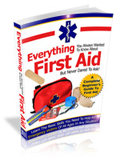Welcome to lacerations Guide
Define Lacerations Article
 To bookmark this article for further reading, click here.
To bookmark this article for further reading, click here.
Understanding 1st To 4th Degree Perineal Lacerations
As you labor to give birth your baby makes his/her way down the birth canal. The tissues of your vagina are made to stretch as the baby comes down.
A primiparae—prim-i-para—(woman in first pregnancy) is most likely to receive 4th degree perineal lacerations. Delivering mothers can receive 4th degree perineal lacerations even with an episiotomy.
To understand perineal lacerations, let’s take a look at them from the least severe to the most.
1st degree perineal lacerations are least serious. There may be nicks and tears around the opening of the vagina, but the tears are only skin deep. The tears are so superficial that they don’t require any suturing.
1st degree lacerations heal very quickly, because they area is endowed with a rich blood supply.
2nd degree perineal lacerations are a bit more involved. These tears penetrate the vaginal mucosa and into the muscles. These tears are sutured with stitches that dissolve in a few weeks. By the time the tears are healed the stitches are gone.
3rd and 4th degree perineal lacerations occur most likely when an episiotomy has been preformed. As the baby is delivered the area that has been cut with an episiotomy tears on its own; the head and shoulders of the baby stretch the tissue that has been cut by the episiotomy.
Women most at risk for 4th degree perineal lacerations are first time mothers with an episiotomy; however 4th degree perineal lacerations can occur with a very large baby, or if the deliver is being assisted with forceps.
A posterior delivery, one in which the baby is born with its face pointing up, is another factor that could cause huge tears. If at all possible when the baby is presenting face up, the doctor will try to turn the baby before the delivery.
Sometimes—if the baby is big—to prevent the trauma of 4th degree perineal lacerations, the doctor will decide to take the baby by Cesarean Section.
Both 3rd and 4th degree lacerations require suturing. A pudendal block is usually administered—an injection of local anesthesia into the pudendal nerve in the vagina—to numb the vagina and perineal and also rectal area.
Repair of 3rd and 4th degree perineal lacerations are very involved. The physician has to suture the area at each layer of muscle and then finally suture on the surface of the perineal area.
The mother with 4th degree lacerations may have problems after the repair. Healing will be slow, and the pain will be a constant companion for a couple of weeks. It is imperative that woman’s doctor orders a stool softener, because with 4th degree perineal lacerations the anal sphincter has been severed.
Moving the bowels without a stool softener can reopen the sphincter. A complication of 4th degree perineal lacerations is that the woman may have problems with fecal incontinence, and she may also be incontinent of flatus. Often women who have had 4th degree lacerations have to have corrective surgery later on.
A woman who is pregnant again after having such trauma should consider finding a doctor who delivers without routinely performing episiotomies.


